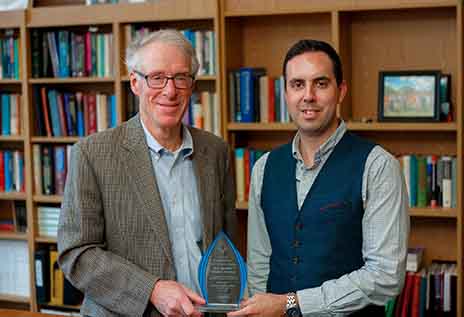
Dr Jon Wolpaw, developer of Spinal Reflex Conditioning, and research team member Dr Amir Eftekhar with a recent award for “Most Innovative” at the 2017 ACRM Launchpad Competition. (Photo courtesy of TREAT)
A newly developed rehabilitation option called Spinal Reflex Conditioning targets the underlying reflex abnormalities common in people with chronic neurological disorders.
With help from the Center for Translation of Rehabilitation Engineering Advances and Technology (TREAT), the therapy is moving out of the lab and into the clinic.
Developed by Dr Jonathan R. Wolpaw, director of the National Center for Adaptive Neurotechnologies (NCAN), and Dr Aiko Thompson at the Medical University of South Carolina, Spinal Reflex Conditioning aims to produce beneficial plasticity in the abnormal reflex pathways in patients with stroke, TBI, MS, and cerebral palsy. Reflex abnormalities are common in such patients and could make movement difficult, painful, and sometimes impossible.
Via the system, patients participate in a training program developed to help produce long-term changes in neuromotor control of functions like walking, notes a media release from TREAT.
To translate the rehabilitation device into a clinically available treatment, Health Research Inc (HRI)—a nonprofit affiliate of the New York State Department of Health—applied for an assistance grant from TREAT.
As part of its assistance, TREAT provided a strategic assessment of the Spinal Reflex Conditioning system to the HRI and NCAN team; advised them to talk to potential users to determine the issues and possible barriers critical to its adoption and success; and helped HRI and NCAN design studies that could provide the data to help physical and occupational therapists decide whether to adopt the therapy in their clinics.
“TREAT is using a methodology that is unique,” says Robert Gallo, director of Intellectual Property and Licensing at HRI, in the release. “TREAT’s framework has made the process of taking an invention from the lab to market more understandable to our researchers.”
Dr Jon Lurie, Co-Director of TREAT and a professor of Medicine and Orthopedics at the Geisel School of Medicine at Dartmouth, adds that, “A major part of introducing a new therapy into today’s healthcare market includes demonstrating not only that it is safe and effective for regulatory purposes but also that it improves outcomes that are important to key stakeholders—those who are likely to recommend, use and/or pay for the technology—and that it provides greater or equal value compared to existing care.”
[Source: Center for Translation of Rehabilitation Engineering Advances and Technology]


